
This article appeared in the Vol. 24 No. 1 / Spring-Summer 2017 issue of West 86th.
In 1850, an eleven-year-old Indian prince named Duleep Singh was ordered to complete a fraught diplomatic task: his mission was to present Queen Victoria with the famed Koh-i-Noor diamond in a contrived spectacle to show Indian submission to British rule. The history of the diamond in England reveals the malleability of the jewel as a symbol of Oriental excess and economic gains through colonial domination, and as an ornament to accentuate Queen Victoria’s femininity while affirming Prince Albert’s masculine identity. This article examines the display and treatment by the British of the Koh-i-Noor diamond with an emphasis on the feminization of the jewel, the Indian subcontinent, and Queen Victoria herself.
Of the many important jewels that circulated among Indian empires, dynasties, and courts, the Koh-i-Noor (“Mountain of Light”) possessed the most lore and signified the greatest power. Worn on the turbans and arms of men, the diamond was an emblem of conquest that expressed the wearer’s divinity, prosperity, authority, and noble virility. In the South Asian context, the ideal body—one full of vigor and beauty—is always the body adorned, and it is, in particular, the royal male body that is most heavily ornamented in jewels. This expression of masculine power through the display of jewelry led many Europeans to associate the dress and consumption habits of Indian rulers with those of Western women, providing one of several justifications for the emasculation of Indian men during the colonial period.
This conflicting vision of masculinity and femininity is one of the central issues addressed in this analysis of the social life of the Koh-i-Noor from its final moments in India to its installation in the British crown jewels, focusing in particular on the diamond’s transformation from a power symbol of royal Eastern men into an accessory for royal British women. There are certainly stones that are larger or more beautiful than the Koh-i-Noor, but having passed through the hands of many legendary rulers, and with a remarkably rich mythological past, the diamond embodies an allure and mystique that no other jewel can claim. Danielle Kinsey has thoroughly and convincingly presented the feminized display of the Koh-i-Noor at the Great Exhibition of 1851 as an emblem of Eastern interests in luxury and excess. This paper takes Kinsey’s central ideas as its starting point, further arguing that the diamond served to articulate and uphold the masculinity of Prince Albert and the femininity of Queen Victoria through its own effeminizing physical transformation and subsequent performative function on the body of the queen.
The Koh-i-Noor in Lahore (1813–1850)
The founder of the Sikh empire, Maharaja Ranjit Singh, acquired the Koh-i-Noor when he overthrew the king of Kabul, Shah Shuja, in 1813. A report of this encounter was published in Harper’s New Monthly Magazine in 1859:
The manner of surrender of this diamond to the conqueror shows the tenacity with which the Indian Princes cling to their great gems. Threats and diplomacy were used in vain to make Shoojah present the gem to his conqueror. Finally they met and took their seats in solemn silence, which continued unbroken for an hour. At length Runjeet became impatient, and sent an attendant to quicken the action of Shoojah. The conquered prince spoke not a word, but made a signal to an attendant who retired for a moment and returned with a small roll, which he laid down half-way between the chiefs. After another silence, at a sign from Runjeet the roll was unfolded, and there was the Koh-i-Noor in all its unapproachable brilliancy.1
During his reign, Ranjit Singh had amassed an unparalleled collection of important jewels that included the Koh-i-Noor, the 186-carat pink diamond known as the Daria-i-Noor (“Ocean of Light”), and the 361-carat red spinel called the Timur Ruby (fig. 1). Yet the Koh-i-Noor was for him, as for those before him who had owned the diamond, his most prized possession.2 Worn in an armlet, the diamond was a symbol of triumph and a source of great pride (fig. 2).3
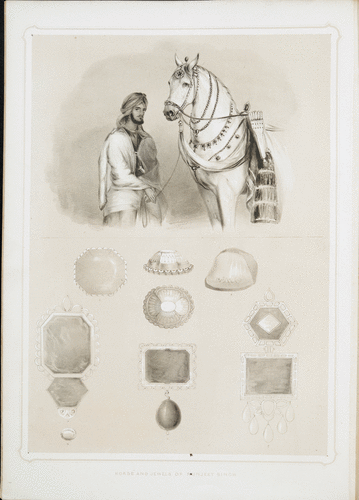
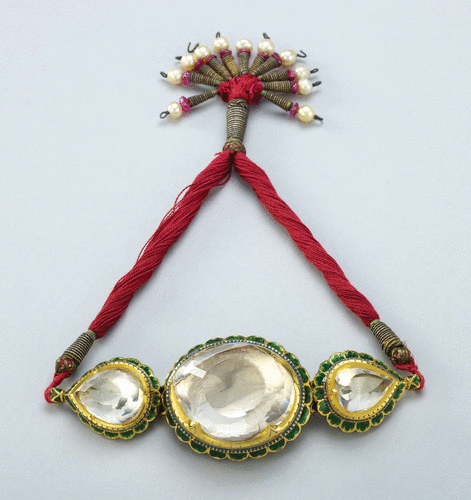
Following his death in 1839, three weak successors all died shortly after ascending the throne, leaving Ranjit Singh’s wealthy kingdom to his youngest son, the five-year-old Duleep Singh, in 1843. The next six years were riddled with instability; the two Anglo-Sikh Wars took place and subsequently led to the annexation of the Punjab by the British in 1849.4 Civil authorities banished Duleep Singh’s mother, Maharani Jind Kaur, and took possession of the Lahore treasury as property of the state to be “confiscated to the East India Company in part payment of the debt due by the Lahore Government and of the expenses of war” (fig. 3).5
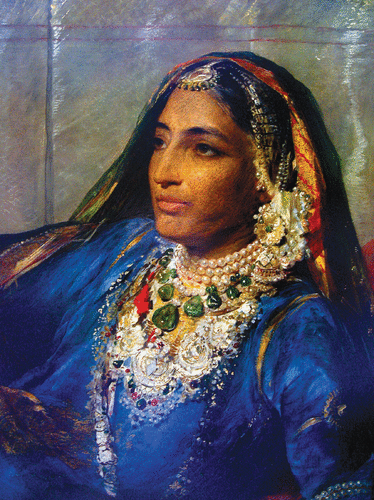
While the entirety of the Lahore treasury was designated as war booty, the governor-general of India, James Andrew Broun-Ramsay (the future Lord Dalhousie), singled out the Koh-i-Noor and set his sights on offering it to Queen Victoria with the aspiration that the diamond should be assimilated into the crown jewels. For this reason, one of the specific terms of the Treaty of Lahore stated that “the gem called the Koh-i-noor which was taken from Shah Shuja-ul-Mulk by Maharajah Ranjit Singh shall be surrendered by the Maharajah of Lahore to the Queen of England.”6 There were many objects of superior beauty and more impressive design in the Lahore treasury, but Dalhousie chose for the queen the most legendary one. He wrote in his diary:
The Koh-i-Noor has ever been the symbol of conquest. The Emperor of Delhi had it in his Peacock Throne. … [W]hile Shah Shuja-ul-Mulk was king, Ranjit Singh extorted the diamond by gross violence and cruelty. And now when, as the result of unprovoked war, the British Government has conquered the kingdom of Punjab, and has resolved to add it to the territories of the British Empire in India, I have a right to compel the Maharaja of Lahore, in token of his submission, to surrender the jewel to the Queen, that it may find its final and fitting resting place in the crown in Britain. For there is not one of those who have held it since its original possessor, who can boast so just a title to its possession as the Queen of England can claim after two bloody and unprovoked wars.7
Given the rich biography of the Koh-i-Noor as an emblem of conquest, its introduction into the crown jewels seemed an effective manner by which to memorialize and enshrine the downfall of India and its conclusive assimilation into the British Empire.
Dalhousie arranged a diplomatic spectacle in which Duleep Singh would offer the diamond to Queen Victoria as a token of his submission. In his official notes from the durbar (ceremonial meeting), Dalhousie writes of the young maharaja that he is “endued with an intelligence beyond his years, and [he] cannot be supposed to have been ignorant of the purpose for which the Durbar was now convened.”8 The eleven-year-old orphan-king surrendered the armlet containing the Koh-i-Noor, and on May 16, 1850, it was put on a ship bound for England.9 Nearly two months later, on July 3, the Koh-i-Noor was presented to Queen Victoria at Buckingham Palace.
The Koh-i-Noor in London and the Great Exhibition of 1851
The Koh-i-Noor’s arrival in London could not have been better timed. Although powerful royals throughout Europe possessed important diamonds, Britain’s queen had none. The consort of King George III, Queen Charlotte (1744–1818), had been rather infamous for wearing diamonds, and critics of her consumption habits were regularly preoccupied with the amount of diamond jewelry she owned and wore.10 This criticism of her jeweled presentation resulted in subsequent British royal women wearing diamonds far more selectively and sparingly. On the other hand, the restored French monarchy possessed the 140-carat Pitt diamond and Catherine the Great had installed the 190-carat Orlov diamond into the Russian imperial scepter. Diamonds possessed an increasingly important function in the presentation of the royal body—particularly the body of a queen—so the moment was apt for Victoria to receive and wear a large, important diamond through which she could assert her royal authority while simultaneously enhancing her feminine presentation.
Prince Albert was particularly enthusiastic about the Koh-i-Noor’s arrival and planned to use its exotic allure to generate further interest in the Great Exhibition of the Works of Industry of All Nations, set to open in less than a year (fig. 4). Political and social upheaval had plagued Europe for years, and the Great Exhibition of 1851 was to provide a space for healthy competition between nations—a global battle of one-upmanship in the realms of science, industry, and technology—all in the spirit of universal uplift and progress.11 As Victoria’s “Prince Consort,” he had no official power or duties attached to his title. Indeed, many of the features typically associated with royal masculinity were withheld from him and possessed by his wife; she was a queen, a future empress, and the wielder of great social, political, and economic power. Involvement in projects that emphasized the masculine domains of science and progress—like the Great Exhibition of 1851—was one of the ways in which Albert could demonstrate and assert his masculinity, fashioning himself as a man of vision and innovation. The success of the Great Exhibition would be a proclamation to his wife’s subjects of his own economic and cultural prowess.
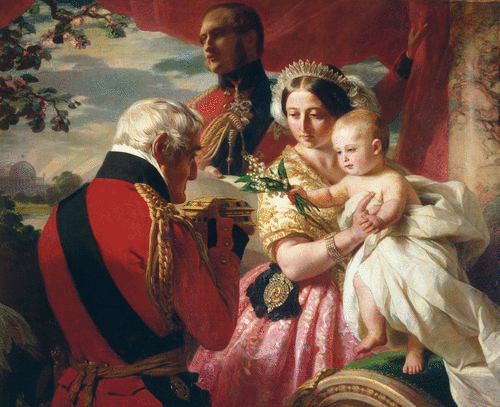
That the public perceived the Prince Consort as submissive and weak is evident in a number of cartoons that highlight concerns and popular perceptions about his questionable masculinity. A lithograph from 1840, for example, commemorates the moment in which Victoria famously proposed to her handsome German cousin (fig. 5). Albert sits up rigidly with a passive, coy expression on his lowered face. He appears reserved and coquettish, clenching his top hat nervously between his legs and too bashful to meet Victoria’s adoring gaze. In contrast, the queen unabashedly wraps her right arm over his shoulder. With her left hand she strokes Albert’s chin, immodestly expressing her affection physically. The words “Albert will you marry me?” stream out of her mouth and are projected on the wall behind them, next to an image of Victoria as queen, standing autonomously as the great British monarch.
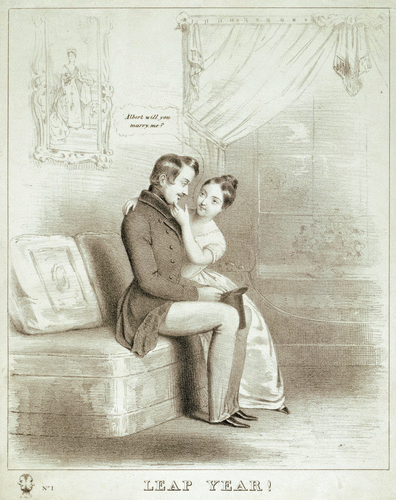
The queen was certainly aware of the imbalance of power that existed within her marriage and the challenge this posed to society through the inversion of traditional gender conventions. To address this, she effectively strategized modes of presentation that would ease tensions in her subjects about her roles as both sovereign and dutiful wife while enhancing Albert’s manliness. This was accomplished largely through the production of collectible cartes de visite intended for mass distribution, staged as a “spectacle of royal domestic privacy,” in which she fashioned herself as a doting wife to her physically powerful husband.12 Such images, comprehensively discussed by numerous scholars including Margaret Homans and Anne M. Lyden, demonstrate one of several ways in which the royal couple constructed or manipulated public perceptions of the power dynamics within their relationship by stressing Victoria’s femininity and highlighting Albert’s masculinity. Another way in which the couple could adhere to gender conventions of the time was through the prince consort’s publicized involvement in projects related to the masculine realms of economic, technological, and scientific advancement. This strategy, as I will soon demonstrate, also implicated the Koh-i-Noor diamond.
With the legendary jewel now in London, Albert began to use its exotic allure aggressively to publicize the Great Exhibition of 1851 at which it would be unveiled to the public. The Crystal Palace—itself a tremendous feat of technology—was erected in Hyde Park specifically for the event, and thirty thousand square feet of it were allocated for the exhibition of India. The India court was prominently positioned near the main entrance of the Crystal Palace and filled the west side of the building’s north–south transept. The East India Company and appointed members responsible for the India court sought to display and narrate their version of an authentic India—one that would dazzle the masses of visitors and reveal to them the many benefits to be gained through occupation.13This “faithful picture” of India emphasized two extremes: a timeless, fertile, largely untapped wellspring of resources and a land of garish decadence and unfathomable excess.
Visitors to the India court were immediately struck by a gold howdah owned by the queen which was perched on the back of an imposing stuffed elephant at the center of the exhibit (fig. 6). The taxidermied animal had been brought in from Essex, dressed up in colorful fabrics, and adorned with ornaments hanging from its ears. The flamboyantly festooned elephant mirrored the effeminate “barbaric pomp” of Indian rulers presented at the exhibition while explicitly highlighting British domination over the once powerful land.14 Other contributions of India included raw materials, “innumerable specimens of wood,” precious metals, fabrics, carpets, shawls, ivory, and a “profusion of gold and gems, rubies and diamonds, emeralds and pearls.”15
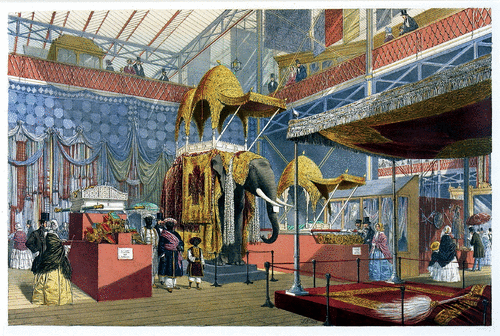
In addition to jeweled armory and gem-studded princely clothing, a cabinet in the India exhibit contained a dazzling array of ornaments, many of which had previously been housed in the Lahore treasury along with the Koh-i-Noor. The famed Daria-i-Noor had been heavily publicized in papers before the exhibition opened and appeared in an armlet, a massive pink table-cut diamond surrounded by ten smaller diamonds. Reports circulated about its exceptional quality and inconceivable value, but like many of the jeweled objects in the India court, its opulence was jarring to visitors, with one observer calling it “a gem of prodigious beauty, but obscured by the tastelessness of its setting.”16 The sartorial conventions of South Asian kingship had for a long time captured the attention of European travelers to the subcontinent whose fascination with and aversion to the bejeweled male body appear in numerous personal accounts about the Eastern rulers’ predilection for extravagance and luxury.17 Such reactions persisted among visitors who strolled through the India exhibit, aligning the princely opulence of India with exorbitant vanity and excess. At the Great Exhibition, the masculine pursuits of progress, machinery, industry, and science were clearly differentiated from feminine concerns with jewelry, clothing, textiles, and luxury. This division effectively aligned the interests and behaviors of Indian rulers with the consumption habits of women. Indeed, the process of miniaturizing and domesticating India at the Crystal Palace was simultaneously a process of feminizing the subcontinent.
Touted by the press as the “Lion of the Great Exhibition,” the Koh-i-Noor sat in its own specially designated exhibition space, isolated from the timeless “fairyland” of the India court. The three diamonds of Ranjit Singh’s armlet were removed from their setting and suspended between prongs in a manner that presented them in a more raw form (fig. 7). The Koh-i-Noor and its sister diamonds were displayed under a structure described by the Illustrated London News as “a golden cage or a prison” and by another observer as a “great parrot-cage with gilded bars,” topped with a small golden crown.18 The grandiose display was ostensibly to protect the stones from theft, but this method of display also meant that viewers could only see the diamonds from a considerable distance, through the bars of a cage, and finally under a glass dome within which they were contained. Beneath its imposing enclosure, the diamond “appeared the size of a pigeon’s egg” or, as another spectator remarked, “not bigger than half a fair-sized walnut.”19 The “Mountain of Light” that had been so widely reported in the press was rendered minuscule and unimpressive under the formidable confines of the British crown.
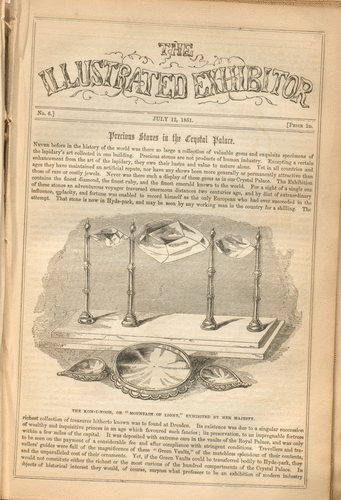
In addition to being thoroughly miniaturized and domesticated through its display, the Koh-i-Noor was also, like the India court, presented as a spectacle with a feminine appeal. Women in particular were reported as losing all sense of civility and public grace in the presence of the Koh-i-Noor. It was designated as “the loadstone [sic] of the fairer sex,” and one visitor remarked, “Wherever the ladies obstruct circulation and crowd one on the other you may be sure there are jewels exhibited.”20 An illustration in the satirical weekly publication Punch demonstrates this correlation between women and the Koh-i-Noor diamond, as ladies in their imposing hoop skirts swarm around the jewel, which is completely hidden from view (fig. 8). The gold enclosure towers over them, its voluminous shape mimicking the rounded edges of the women’s skirts. The cage itself appears like a giant hoop skirt with a crown at its top, transforming the diamond’s confines into the imperial body of Queen Victoria, who subsumes the Koh-i-Noor and, by extension, all of India represented by it.
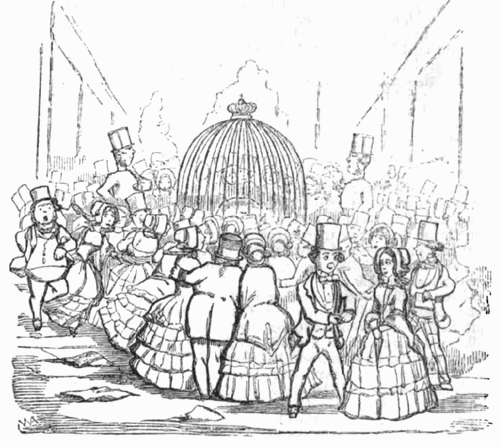
For hours, crowds waited to catch a glimpse of the fabled Koh-i-Noor, which “disappointed the public in no ordinary degree.”21 Assuming it would be much larger, many were dismayed at its size, while others were confused by its “ungraceful peculiarity of shape” and the “ineffective manner” in which it had been cut.22 In describing the appearance of the diamond, one author wrote rather unfavorably, “It was however almost devoid of shape. That it did not possess any beauty as an ornament, at least in that respect, may be surmised when we state that its conformation was, as near as possible, that of the hulk of a vessel, one of whose stern corners had been completely sliced off.”23 Most disappointing of all, however, was that the diamond failed to shine. Under its massive cage, the stone “had by no means the dazzling lustre that its romantic history … would naturally lead you to expect.”24 Various efforts were made to improve its appearance throughout the duration of the Great Exhibition, but nothing was successful at increasing its sparkle. “To ordinary eyes it is nothing more than an egg-shaped lump of glass. … On ordinary days, that is, the shilling days, it is exposed in its great cage, ornamented with a policeman, and they rely on the sun to cause it to sparkle; but on the Friday and Saturday it puts on its best dress; it is arrayed in a tent of red cloth, and the interior is supplied with a dozen little jets of gas, which throw their light on the god of the temple. Unhappily, the Koh-i-Noor does not sparkle even then.”25 After all the attention that the Koh-i-Noor had garnered in the press before the opening of the Great Exhibition, even in “its best dress” the boorish “mountain” was no larger than a nut, and the “light” it cast paled in comparison even to the dull English sun.
Improving the Koh-i-Noor
Disheartened and ashamed by the diamond’s reception, Prince Albert resorted to science and technology to improve the Koh-i-Noor. He wanted the stone recut, an assault on the jewel that would increase its luster but inevitably reduce its size. That its shine did not meet the expectations of the public was due in large part to the manner in which it had been cut for its Eastern owners. Diamonds were first discovered and traded in India as early as the fourth century BC, and of greatest value to Indians was the crystal’s octahedral shape.26 Interest had long been in preserving as much of the diamond’s natural size and shape as possible for the wearer to benefit most from the stone’s talismanic properties. The Koh-i-Noor was shaped in what is today referred to as the mughal cut, defined in the 1977 Diamond Dictionary as “an older style of cutting which is a rather lumpy form with a broad, often asymmetrical base, an upper termination consisting of a set of usually four shallow facets or a table, and two or more zones of strip facets parallel to the base and oriented vertically. It is derived from cleavage pieces” (fig. 9).27 This method of cutting the stone generally required far less intrusion and loss than the rose cut and the later brilliant cut, both of which enhanced the diamond’s light effects through many small, inclined facets.28 These more complex methods of cutting were preferred in Europe, with ever-increasing efforts to achieve perfect symmetry and the most brilliant sparkle. The Koh-i-Noor did not, therefore, conform to European tastes and was viewed as cumbersome, “badly mutilated,” and in “an incomplete condition.”29
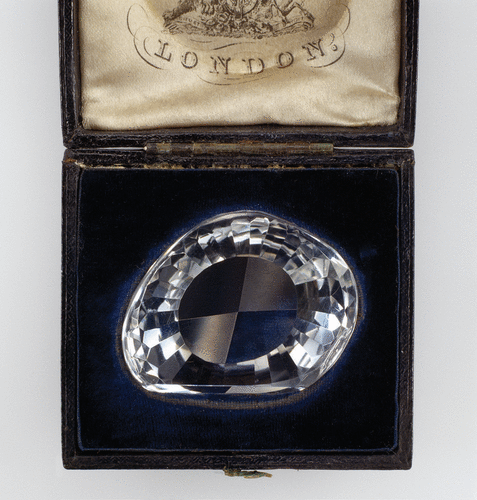
To correct the diamond, Albert first contacted a number of British academic scientists to seek their advice on how best to refashion the stone and release from the jewel its fullest light.30 He next approached diamond cutters, many of whom refused to be implicated in the cutting of the Koh-i-Noor out of concern that it would be irreparably damaged.31 A plan for the stone’s recutting was devised and submitted by the Coster firm in Amsterdam, assuring Albert that only a negligible amount of the carat weight would have to be discarded in the process. The plan was accepted and, on July 16, 1852, the aggressive procedure of reshaping the diamond began.32 To inaugurate the process, the eighty-three-year-old Duke of Wellington was invited to make the first cut. He was the great savior of the empire and most venerated military leader in Britain for his successful campaigns in India and, more important, for having defeated Napoleon at Waterloo. As the emblem par excellence of British masculinity, his appointment as the first to strike the diamond further suggests an assertion of British masculine forces on the former emblem of Indian masculine power.
The press once again eagerly publicized Albert’s role in the process as a pioneer of progress, with a squadron of supportive scientists, technicians, and military heroes at his behest. He personally oversaw the thirty-eight-day process of the Koh-i-Noor’s transformation; like the Great Exhibition in the previous year, the cutting of the diamond became his project, through which he could assert his masculine identity and inscribe it permanently onto the stone. The primacy of British technology, machinery, and taste would be carved into the Koh-i-Noor, and, if successful, it would be a victory both for Britain and for the prince consort. While the London press reiterated the Coster firm’s promise that the diamond could be cut without greatly reducing its size, the claim quickly unraveled as it became evident that the stone could not sustain such a drastic alteration without significant loss. In the end, 43 percent of the Koh-i-Noor’s original carat weight was lopped off; the legendary 186-carat mughal cut diamond was replaced by a 105-carat oval stellar brilliant.33
The Second Koh-i-Noor (1852–)
Meanwhile, in India, the deposed maharaja Duleep Singh was enduring his own civilizing process, having been placed by Dalhousie in the care of John and Lena Login in 1849. At age twelve, he decided of his own will to convert to Christianity and was enthusiastic about a visit to England. In an appeal to the Government House for permission to travel, the young maharaja wrote, “I wish to say that I am very anxious to go, and quite ready to start whenever his Lordship gives me permission. I do not want to go to make a show of myself, but to study and complete my education, and I wish to live in England as quietly as possible.”34 Permission was granted, and he arrived in London in the summer of 1854.
Upon meeting him, Queen Victoria was so impressed by the fifteen-year-old maharaja’s handsome Sikh costume that she had Franz Winterhalter paint his portrait. A favorite of Victoria’s, the artist had Duleep Singh stand on a dais in order to elongate his stocky frame, explaining to him that he would “grow into” the picture. As the maharaja remained rather short his entire life, the painting portrays a svelte and excessively flattering version of the subject.35 Winterhalter’s painting depicts the young king in his Indian finery, dressed in silks and wearing some of the jewels he was allowed to keep when the Lahore treasury was confiscated (fig. 10). Set against an imagined desert landscape with minarets and a dome in the distance, Duleep Singh stands in all his exotic princely splendor.
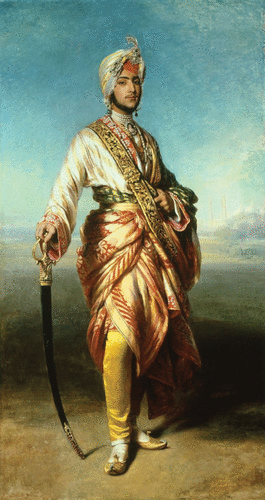
Amid his many jewels, a small portrait of Queen Victoria hangs off a five-strand pearl choker he wears tightly around his neck, a pendant that displays both his allegiance to and dependence on the queen.
It was while he was posing for his portrait that Victoria decided to show Duleep Singh the new Koh-i-Noor. An account from Mrs. Login’s memoirs describes the awkward encounter, during which the maharaja saw and touched his diamond that had been reduced to nearly half its size:
[A] slight bustle near the door made me look in that direction, and [I] beheld, to my amazement, the gorgeous uniforms of a group of beef-eaters from the Tower, escorting an official bearing a small casket, which he presented to Her Majesty. This she opened hastily, and took therefrom a small object which, still holding, she showed to the Prince, and, both advancing together to the dais, the Queen cried out, “Maharajah, I have something to show you!” … Duleep Singh stepped hurriedly down to the floor, and, before he knew what was happening, found himself once more with the Koh-i-Noor in his grasp, while the Queen was asking him “if he thought it improved, and if he would have recognized it again?” … [A]s he walked towards the window, to examine it more closely, turning it hither and thither, to let the light upon its facets … there was a passion of repressed emotion in his face, patent to one who knew him well, and evident, I think, to Her Majesty, who watched him with sympathy not unmixed with anxiety—that I may truly say, it was to me one of the most excruciatingly uncomfortable quarters-of-an-hour that I ever passed! … seeing him stand there turning and turning the stone about in his hands, as if unable to part with it again, now he had it once more in his possession! At last, as if summoning up his resolution after a profound struggle, and with a deep sigh, he raised his eyes from the jewel and … moved deliberately to where Her Majesty was standing, and, with a deferential reverence, placed in her hand the famous diamond, with the words: “It is to me, Ma’am, the greatest pleasure thus to have the opportunity, as a loyal subject, of myself tendering to my sovereign the Koh-i-Noor!”36
When news reached Dalhousie of Duleep Singh’s gesture, he wrote that the “talk about the Koh-i-Noor being a present from Dhuleep Singh to the Queen is arrant humbug. He knew as well as I did that it was nothing of the sort: and if I had been within a thousand miles of him he would not have dared to utter such a piece of trickery.”37 Duleep Singh made no mention then or ever about the many other jewels of the Lahore treasury that had, since their display at the Crystal Palace, been given to Queen Victoria by the East India Company “as a reward for her interest in their exhibit.”38 Later in life, however, he would refer to the queen as “Mrs. Fagin,” a receiver of stolen goods, and make several unsuccessful attempts to reclaim the Koh-i-Noor and his kingdom, both of which he felt had been unjustly obtained.39
The jewel-wearing kings of India had come to be aligned with opulence and femininity in England, with many of their precious gems, like Duleep Singh’s Koh-i-Noor, finding new homes on the bodies of English women. Marcia Pointon has proposed that diamonds worn on the bodies of British royal women could be read symbolically as expressions of fecundity and fertility (as opposed to pearls, which had become synonymous with the virginal self-fashioning of Queen Elizabeth I).40 Yet, though diamonds in Europe were worn on women’s bodies, it was men who dominated the economic and scientific fields associated with them, establishing areas in which they could be involved with diamonds “without compromising ideas about their masculinity.”41 Thus, staging diamonds on the body of a woman asserted a man’s wealth and power while simultaneously accentuating the wearer’s feminine beauty.
The Koh-i-Noor that had adorned the brows and biceps of Indian despots for generations was transformed into an ornamental brooch on the breast of the queen, with Prince Albert orchestrating and supervising the entire procedure (fig. 11). Wearing the diamond was yet another way in which Victoria’s private and public identities were conflated, bridging her body politic as female monarch with her body natural or body personal as adored (and adorned) wife.42 Through it, she managed to enhance her feminine public persona, announce the power and affection of her husband, proclaim her imperial fortitude, and assert the conclusive subordination of India under her rule—all with just one stone.
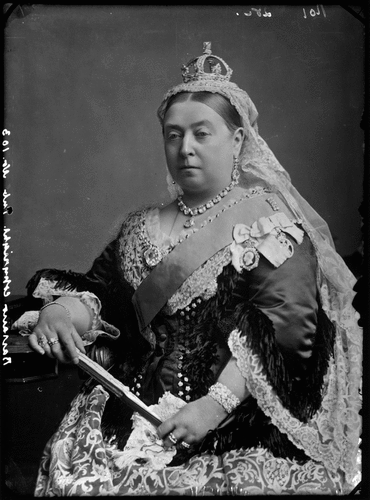
During Victoria’s life, the Koh-i-Noor was set in a brooch, a bracelet, a tiara, and a regal circlet and continued to be reset following her death in 1901.43 The diamond was placed in the crown worn by Alexandra for the coronation of her husband, King Edward VII, and subsequently by the queen consorts Mary in 1911 and Elizabeth in 1937. Elizabeth, the queen mother, was the last royal to wear the diamond, which was the central stone of her crown for the coronation of Queen Elizabeth II in 1953. Since its arrival in England, and in keeping with the British effeminization of the Koh-i-Noor, the diamond has never been worn by a male, reserved exclusively for the adornment of queen consorts since the death of Victoria.44
Conclusion
The miniaturized, feminized, and domesticated India presented at the Crystal Palace stood in stark opposition to the grand masculinist principles of science, industry, and progress advocated by the Great Exhibition. The Koh-i-Noor itself endured a process of emasculation through its reduction and subsequent deployment as a decorative ornament reserved exclusively for women. That the Koh-i-Noor’s life in Britain is a metaphor for the civilizing mission inflicted on India is perhaps nowhere more evident than in the famous words of John Forbes Royle, who, in 1849, did not say that India was “the jewel in the crown” of the British Empire, but rather that India was the “Koh-i-Noor of the British Crown.”45 Though its association with India is less palpable today than it was in the nineteenth century, in its altered form and current setting the diamond remains associated with imperial conquest and royal femininity.
The process of feminizing the stone heightened Albert’s masculine presentation through his imposition of Western science and technology on the diamond as well as his essential role in transforming the stone from a jewel of kings to an heirloom on his wife’s breast. When worn by Victoria, the Koh-i-Noor was more than just a symbol of India’s subservience; it was, as with other British women who displayed diamonds, a declaration of her husband’s masculine power. In India the Koh-i-Noor had always been a power symbol of men, worn in their turbans and on their biceps as an emblem of valor and fortitude. In England, too, the diamond passed through the hands of many men who used it to assert their masculinity—at the jewel’s expense, however. Today, the Koh-i-Noor’s legacy among emperors, sultans, and maharajas has been erased entirely from its context and surface. Enshrined behind bulletproof glass at the Tower of London, the diamond remains a static symbol of the former submission of India to the British crown and as a decorative ornament in the regalia of British royal women.
Siddhartha V. Shah is a PhD candidate at Columbia University, specializing in South Asian and nineteenth-century European art. His research focuses on the opulence of the British Raj, emphasizing the role of traditional Indian ornament in displays of imperial power.
I am grateful to Vidya Dehejia, Anne Higonnet, Nancy Rose Marshall, and Meredith Martin for guidance and valuable suggestions. Archival research in the UK was made possible through the generous support of the Dr. Lee MacCormick Edwards Fellowship at Columbia University.
- 1. “Something about Diamonds,” Harper’s New Monthly Magazine, vol. 19 (1859), 478.
- 2. Danielle C. Kinsey, “Koh-i-Noor: Empire, Diamonds, and the Performance of British Material Culture,” in Journal of British Studies 48, no. 2 (April 2009): 395.
- 3. Ian Balfour, Famous Diamonds (London: Christie, Manson and Woods, 1997), 167.
- 4. Ibid.
- 5. Hipponax Roset [Joseph Rupert Paxton], Jewelry and the Precious Stones: With a History, and Description from Models, of the Largest Individual Diamonds Known (Philadelphia: Pennington and Son, 1856), 21.
- 6. Balfour, Famous Diamonds, 167.
- 7. Kinsey, “Koh-i-Noor,” 396.
- 8. Ibid., 394.
- 9. Balfour, Famous Diamonds, 168; Michael Alexander and Sushila Anand, Queen Victoria’s Maharajah: Duleep Singh, 1838–93 (New York: Taplinger, 1980), 15. Though Dalhousie arranged a durbar in which Duleep Singh was personally to offer the Koh-i-Noor to Queen Victoria, the young king did not arrive in London or meet Victoria until the diamond was already in her possession. What actually took place at this durbar, including how and to whom Duleep Singh gave the stone, is not clear.
- 10. Kinsey, “Koh-i-Noor,” 391.
- 11. Jeffrey A. Auerbach, The Great Exhibition: A Nation on Display (New Haven, CT: Yale University Press, 1999), 27.
- 12. Margaret Homans, “‘To the Queen’s Private Apartments’: Royal Family Portraiture and the Construction of Victoria’s Sovereign Obedience,”Victorian Studies37, no. 1 (Autumn 1993): 4.
- 13. Lara Kriegel, “Narrating the Subcontinent in 1851: India at the Crystal Palace,” in The Great Exhibition of 1851: New Interdisciplinary Essays, ed. Louise Purbrick (New York: Manchester University Press / Palgrave, 2001), 152.
- 14.“India and Indian Contributions to the Industrial Bazaar,” in Illustrated Tribute to the World’s Industrial Jubilee: Sketches, by Pen and Pencil, of the Principal Objects in the Great Exhibition of the Industry of All Nations (London: J. Cassell, 1852), vol. 4 of The Great Exhibition: A Documentary History, ed. Geoffrey Cantor (London: Pickering and Chatto, 2013), 218.
- 15. Ibid., 236.
- 16. Ibid., 161.
- 17. An encounter in 1617 between Sir Thomas Roe and the Mughal emperor, Jahangir, conveys the effect of this mode of presentation on a European spectator: “Here attended the Nobilitie, all sitting about it on Carpets until the King came; who at last appeared clothed or rather loden with Diamonds, Rubies, Pearles, and other precious vanities, so great, so glorious … his head, necke, breast, armes, above the elbows, at the wrists, his fingers every one, with at least two or three Rings; fettered with chaines, or dyalled Diamonds; Rubies as great as walnuts, some greater; and Pearles such as mine eyes were amazed at. Suddenly he entered into the scales, sate like a woman on his legges, and there was put in against him many bagges to fit his weight.” See Sir Thomas Roe, The Embassy of Sir Thomas Roe to the Court of the Great Mogul, 1615–1619: As Narrated in His Journal and Correspondence (Hakluyt Society, 1899), 412. During his four years in the court of Jahangir, Roe repeatedly elaborated on the copious jewels worn by the emperor but rarely described his face or bodily features in any detail. See Romita Ray, “All That Glitters: Diamonds and Constructions of Nabobery in British Portraits (1600–1800),” in The Uses of Excess in Visual and Material Culture, 1700–2010, ed. Julia Skelly (London: Ashgate, 2014), 23. The remark that follows Roe’s lengthy description of the emperor’s adorned body—that he sits on the scales “like a woman”—suggests that a possible correlation between jeweled adornment and femininity informed Roe’s perception of Jahangir.
- 18. John Tallis, History and Description of the Crystal Palace, and the Exhibition of the World’s Industry in 1851 (Cambridge: Cambridge University Press, 2011), 1:150.
- 19. “What the Richer Are We?,” in The Expositor: A Weekly Recorder of Inventions, Designs, and Art-Manufactures, 24 May 1851, 59, vol. 4 of Cantor, The Great Exhibition, 115.
- 20. Kriegel, “Narrating the Subcontinent,” 166; and John Lemoinne, “Letters of M. John Lemoinne,” in The Great Exhibition and London in 1851: Reviewed by Dr. Lardner & C. (1852), 573–92, vol. 4 of Cantor, The Great Exhibition, 10.
- 21. Z. M. W., “A Lady’s Glance at the Great Exhibition,” Illustrated London News, 23 August 1851, 242–43, vol. 3 of Cantor, The Great Exhibition, 160.
- 22. Ibid., 161.
- 23. Roset, Jewelry and the Precious Stones, 12.
- 24.“A Country Minister, Notes of a Visit to the Great Exhibition,” MacPhail’s Edinburgh Ecclesiastical Journal 13 (1852): 84–101 and 214–32, vol. 3 of Cantor, The Great Exhibition, 322.
- 25. Kinsey, “Koh-i-Noor,” 406. Kinsey is quoting John Tallis in Tallis’s History and Description of the Crystal Palace, and the Exhibition of the World’s Industry in 1851 (London, 1852), 2:150.
- 26.Herbert Tillander, Diamond Cuts in Historic Jewellery 1381–1910 (London: Art Books International, 1995), 17.
- 27. Ibid., 64.
- 28. Ibid.
- 29. Ibid., 149. In the appendix to his 1889 translation of Jean-Baptiste Tavernier’s Travels in India, V. Ball wrote that the Koh-i-Noor, when it first arrived in London, “had been badly mutilated, after cutting, and that it cannot have been left in such an incomplete condition by the jeweller who cut it and polished it.” See Tillander, Diamond Cuts in Historic Jewellery, 149.
- 30. Ibid., 413.
- 31. Ibid., 415.
- 32. Ibid., 416.
- 33. Balfour, Famous Diamonds, 170.
- 34. Alexander and Anand, Queen Victoria’s Maharajah, 39.
- 35. Ibid., 45.
- 36. Ibid., 47–48.
- 37. Balfour, Famous Diamonds, 171.
- 38. Alexander and Anand, Queen Victoria’s Maharajah, 48.
- 39. Ibid., 49.
- 40. Marcia Pointon, “Intriguing Jewellery: Royal Bodies and Luxurious Consumption,” Textual Practice 11, no. 3 (1997): 498 and 503.
- 41. Danielle C. Kinsey, “Imperial Splendor: Diamonds, Commodity Chains, and Consumer Culture in Nineteenth-Century Britain” (PhD diss., University of Illinois at Urbana-Champaign, 2010), 65.
- 42. Homans, “‘To the Queen’s Private Apartments,’” 4.
- 43. Balfour, Famous Diamonds, 171.
- 44. The story of a curse on the diamond that endangers men who wear it is often recounted, perhaps in defense of the practice in England of only deploying the Koh-i-Noor on the bodies of royal women. Indeed, after the diamond arrived in London, a rumor of a curse emerged, possibly started by the Delhi Gazette. The rumor stated that all who possessed the Koh-i-Noor were bound for ruin. This created such a stir in London that Queen Victoria personally wrote to Dalhousie asking if the report of a curse was true. His reply stated that, in fact, the diamond carried “Good Fortune; for whoever possesses it has been superior to all his enemies.” The English newspapers, however, devised an even more effective response—the queen, being a British woman, rendered the curse on the exotic jewel ineffective as it applied “only toward the ‘Oriental’ despot.” Thus, the belief that the jewel can be worn only by women seems to have been fabricated in London and has no precedent in India. See Kinsey, “Koh-i-Noor,” 400–401.
- 45. Kriegel, “Narrating the Subcontinent,” 166.
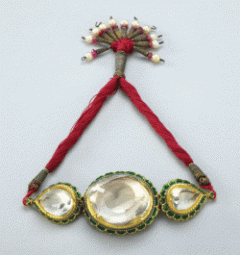
The Koh-i-Noor armlet, ca. 1830. Gold, enamel, rock crystal, glass, rubies, pearls, and silk, 4 × 6 in. (approx. 10 × 15 cm) without fittings. Royal Collection Trust / © Her Majesty Queen Elizabeth II 2016.
